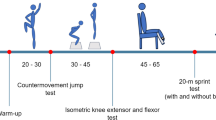Abstract
The aim of the present study was to estimate the damping coefficient (B factor) of the elbow flexor muscles during both eccentric and concentric muscle actions. We used a muscle model consisting of a viscous damper associated in parallel with a contractile component, both in series with an elastic component. The viscous damper allowed the concentric loss and the eccentric gain of force to be modelled. Eight volunteer subjects performed maximal eccentric and concentric elbow movements on an isokinetic dynamometer at angular velocities of 0.52, 1.04 and 2.09 rad·s−1. Torques at an elbow joint angle of 90° were recorded. Electromyogram (EMG) signals from the belly of the right elbow flexor and from the long head of the triceps brachia muscles were recorded using two pairs of bipolar surface electrodes. The root mean square (rms) of the EMG was determined. Eccentric and concentric rms were not significantly different (P>0.05). The B factor was higher in the concentric than in the eccentric conditions (P<0.05), and, whatever the muscle action type it decreased as the velocity increased. These results indicated that the concentric loss and the eccentric gain of force were attributable to the behaviour of the contractile machinery. Furthermore, whatever the exact cause of loss and gain of tension, our study showed that the total effect can be modelled by the viscous damper of a three-component muscle model.
Similar content being viewed by others
References
Asmussen E, Hansen O, Lammert O (1965) The relation between isometric and dynamic muscle strength in man. Dan Nat Ass Infant Paralysis 20:3–11
Bahler AS (1967) Series elastic component of mammalian skeletal muscle. Am J Physiol 231:1560–1564
Carew TJ (1981) Spinal cord I and II. In: Kandel ER, Schwartz JH (eds) Principles of neural science. Arnold, London, pp 284–304
Cavagna GA (1970) Elastic bounce of the body. J Appl Physiol 29:279–282
Close RI (1972) Dynamic properties of mammalian skeletal muscles. Physiol Rev 52:129–197
Edman KA, Elzinga G, Noble M (1978) Enhancement of mechanical performance by stretch during tetanic contractions of vertebrate skeletal muscle fibres of the frog. J Physiol (Lond) 281:139–155
Edman KA, Elzinga G, Noble M (1981) Critical sarcomere extension required to recruit a decaying component of extra force during stretch in tetanic contractions of frog skeletal muscle fibres. J Gen Physiol 78:365–382
Eloranta V, Komi PV (1980) Function of the quadriceps femoris muscle under maximal concentric and eccentric contractions. Electromyogr Clin Neurophysiol 20:159–174
Hortobagyi T, Katch FI (1990) Eccentric and concentric torque-velocity relationships during arm flexion and extension. Eur J Appl Physiol 60:395–401
Hill AV (1922) The mechanism of muscular contraction. Physiol Rev 2:310–341
Hill AV (1938) The heat of shortening and the dynamic constants of muscle. Proc R Soc B 126:136–195
Hill AV (1940) Dynamic constants of human muscle. Prod R Soc B 128:263–274
Hill AV (1950) The series elastic component of muscle. Prod R Soc B 137:273–280
Katz AM (1970) Contractile proteins of the heart. Physiol Rev 50:63–158
Kojima T (1991) Force-velocity relationship of human elbow flexors in voluntary isotonic contraction under heavy loads. Int J Sports Med 2:208–213
Komi PV (1973) Relationship between muscle tension, EMG and velocity of contraction under concentric and eccentric work. In: Desmedt JE (ed) New developments in electromyography and clinical neurophysiology. Karger, Basel, pp 596–606
Martin A, Martin L, Morlon B (1994) Theoretical and experimental behaviour of the muscle viscosity coefficient during maximal concentric actions. Eur J Appl Physiol 69:539–544
Niku S, Henderson JM (1989) Viscosity of the flexor muscles of the elbow joint under maximum contraction condition. J Biomech 22:523–527
Pertuzon E, Bouisset S (1971) Maximum velocity of movement and maximum velocity of muscle shortening In: Cerquiglini S, Venerando A, Wartenweiler J (eds) Biomechanics II. Karger, Basel, pp 170–173
Rodgers KL, Berger RA (1974) Motor unit involment and tension during, voluntary concentric, eccentric, and isometric contractions of the elbow flexors. Med Sci Sports 6:253–259
Sale DG (1988) Neural adaptation to resistance training. Med Sci Sports Exerc 20:135–145
Sugi H, Tsuchiya T (1981) Enhancement of mechanical performance in frog muscle fibres after quick increases in load. J Physiol (Lond) 319:239–252
Taylor NA, Sanders RH, Howick EI, Stanley SN (1991) Static and dynamic assessment of Biodex dynamometer. Eur J Appl Physiol 62:180–188
Tesch PA, Dudley GA, Duvoisin MR, Hather BM (1990) Force and EMG signal patterns during repeated bouts of concentric and eccentric muscle contractions. Acta Physiol Scand 138:263–271
Westing SH, Gresswell AG, Thorstensson A (1991) Muscle activation during maximal voluntary eccentric and concentric knee extension. Eur J Appl Physiol 62:104–108
Wilkie DR (1950) The relation between force and velocity in human muscle. J Physiol (Lond) 110:249–280
Woledge RC (1961) The thermoelastic effect of change of tension in active muscle. J Physiol (Lond) 155:187–208
Author information
Authors and Affiliations
Rights and permissions
About this article
Cite this article
Martin, A., Morlon, B., Pousson, M. et al. Viscosity of the elbow flexor muscles during maximal eccentric and concentric actions. Europ. J. Appl. Physiol. 73, 157–162 (1996). https://doi.org/10.1007/BF00262825
Accepted:
Issue Date:
DOI: https://doi.org/10.1007/BF00262825




